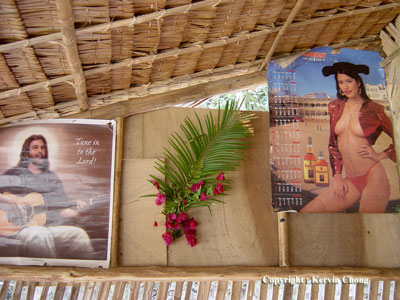Duality
Pic: A picture of Christ (albeit modernized) shares the same honorary space with that of a beer ad featuring a scantly dressed woman. This picture sums up the Filipino people better than any other analogy. Often conflicted by duality, balancing virtues and vices, the Filipinos are searching for a common definition to signify who they are and what they ant to become. Bolinao, Philippines, 2004.
Imbalance development is very apparent in Luzon. You don’t have to travel from Manila to the suburbs to see this contrast, it’s readily apparent within the city limits itself. The rich and the poor often share the same roof. You won’t be missing the creature comforts you’re used to back home though; malls (such as S&M Mall) rivaling most shopping complexes in Kl; SM City’s electronics department is a counterpart of Low Yat with the latest electronic gadgetry and phone models; Coffeebean, Starbucks, Dunkin Doughnuts, Mc Donalds and other world famous franchises are just a walk away; Pubs and cafes serving everything from Chinese cuisines to Mexican; rich boulevards of houses in private walled communities and internationally renowned hoteliers are ever ready to dole out service. Yet between all this prosperity, the simple stark poverty is all prevalent. Shanty houses are piled up one upon the other, hanging precariously over the riverbanks, people bathing in the polluted rivers as they lack fresh water supply, back alleyways are populated with run down shops where cheap goods are bought, high rates of robbery and violence and pollution that covers the city in a fog of grey everyday.
This duality of nature is seen too often here in Manila, concrete jungles rise up ever higher, road and rail edifice blot out the sky, traffic congesting the roadways and urban housing further building up the already crowded city. Yet a passion that I notice for the Philippines is in the building of large iconic memorials. Among these are statues commemorating events and people (Mc Arthur’s return in Cebu, Manila memorial in Manila, Magellan’s Cross, etc), large monuments in wide parklands (President’s Quezon’s Mausoleum), small inconspicuous landmarks that tells of forgotten history and large imposing structures in modern art style. As for history, the people never forgets, Manila has been a city forever rebuilding, from destruction of the Spanish siege of Intramuros, to the fire and massacre of Chinese in the old town to the heavy bombing of Allied forces during world war II, Manila has been leveled and rebuilt countless times to the point that most of the original structures are destroyed but yet they are lovingly rebuilt, the Manila Cathedral, an imposing granite structures in Baroque style has risen anew no less than 3 times. The conservation and use of the old city is vibrant, government buildings housed in century old quarters, the old fort turned into a tourist attraction and calesa (horse drawn carts) rides around town.





No comments:
Post a Comment